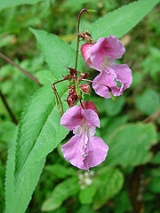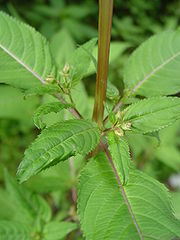
Himalayan Balsam
Encyclopedia
- Policeman's helmet redirects here. For the uniform cover, see: Custodian helmetCustodian helmetCustodian helmet or centurion helmet, technically known as a 'Home Office pattern helmet', is a helmet worn by many policemen in England and Wales.-History:...
.
Impatiens glandulifera is a large annual plant
Annual plant
An annual plant is a plant that usually germinates, flowers, and dies in a year or season. True annuals will only live longer than a year if they are prevented from setting seed...
native to the Himalayas
Himalayas
The Himalaya Range or Himalaya Mountains Sanskrit: Devanagari: हिमालय, literally "abode of snow"), usually called the Himalayas or Himalaya for short, is a mountain range in Asia, separating the Indian subcontinent from the Tibetan Plateau...
. Via human introduction it is now extant across much of the Northern Hemisphere.
Etymology
The common names Policeman's Helmet, Bobby Tops, Copper Tops, and Gnome's Hatstand all originate from the flowers being decidedly hat-shaped. Himalayan Balsam and Kiss-me-on-the-mountain arise from the fact that the plant originates in the Himalayan mountains.The species name glandulifera comes from the Latin words glandis meaning 'gland', and ferre meaning 'to bear', in that the plant has glands
Gland (botany)
In plants, a gland is defined functionally as a plant structure which secretes one or more products. This may be located on or near the plant surface and secrete externally, or be internal to the plant and secrete into a canal or reservoir...
that produce a sticky, sweet-smelling, and edible nectar.
Description
It typically grows to 1 to 2 m (3.3 to 6.5 ft) high, with a soft green or red-tinged stem, and lanceolate leavesLeaf
A leaf is an organ of a vascular plant, as defined in botanical terms, and in particular in plant morphology. Foliage is a mass noun that refers to leaves as a feature of plants....
5 to 23 cm (2 to 9 in) long. The crushed foliage has a strong musty smell. The flower
Flower
A flower, sometimes known as a bloom or blossom, is the reproductive structure found in flowering plants . The biological function of a flower is to effect reproduction, usually by providing a mechanism for the union of sperm with eggs...
s are pink, with a hooded shape, 3 to 4 cm (1¼ to 1½ in) tall and 2 cm (¾ in) broad; the flower shape has been compared to a policeman's helmet
Custodian helmet
Custodian helmet or centurion helmet, technically known as a 'Home Office pattern helmet', is a helmet worn by many policemen in England and Wales.-History:...
, giving rise to the alternative common name Policeman's Helmet. Although it does not range all over India
India
India , officially the Republic of India , is a country in South Asia. It is the seventh-largest country by geographical area, the second-most populous country with over 1.2 billion people, and the most populous democracy in the world...
and is by no means the only Impatiens native to that country, it is also known as Indian Balsam in countries where it is introduced.

Seed
A seed is a small embryonic plant enclosed in a covering called the seed coat, usually with some stored food. It is the product of the ripened ovule of gymnosperm and angiosperm plants which occurs after fertilization and some growth within the mother plant...
s up to 7 metres (23 ft). Impatiens, meaning "impatient", refers to this method of dispersal. The green seed pods, seeds, young leaves and shoots are all edible.
Invasive species
Himalayan Balsam is sometimes cultivated for its flowers. It is now widely established in other parts of the world (such as the British Isles and the United States), in some cases becoming an invasive speciesInvasive species
"Invasive species", or invasive exotics, is a nomenclature term and categorization phrase used for flora and fauna, and for specific restoration-preservation processes in native habitats, with several definitions....
weed
Weed
A weed in a general sense is a plant that is considered by the user of the term to be a nuisance, and normally applied to unwanted plants in human-controlled settings, especially farm fields and gardens, but also lawns, parks, woods, and other areas. More specifically, the term is often used to...
. The aggressive seed dispersal, coupled with high nectar production which attracts pollinators, often allows the Himalayan Balsam to outcompete native plants. In the UK the plant was first introduced in 1839 at the same time as Giant Hogweed
Giant Hogweed
Heracleum mantegazzianum, commonly known as giant hogweed, cartwheel-flower, wild parsnip, wild rhubarb, giant cow parsnip, or giant cow parsley, is a plant in the family Apiaceae. It typically grows to heights of , sometimes reaching...
and Japanese Knotweed
Japanese knotweed
Japanese Knotweed is a large, herbaceous perennial plant, native to eastern Asia in Japan, China and Korea...
. These plants were all promoted at the time as having the virtues of "herculean proportions" and "splendid invasiveness" which meant that ordinary people could buy them for the cost of a packet of seeds to rival the expensive orchids grown in the geenhouses of the rich. Within ten years, however, Himalayan balsam had esaped from the confines of cultivation and began to spread along the river systems of England. Today it has spread across most of the UK and some local wildlife trusts organise "balsam bashing" events to help control the plant. However, a recent study (Hejda & Pyšek, 2006) concludes that in some circumstances, such efforts may cause more harm than good. Destroying riparian stands of Himalayan Balsam can open up the habitat for more aggressive invasive plants such as Japanese knotweed
Japanese knotweed
Japanese Knotweed is a large, herbaceous perennial plant, native to eastern Asia in Japan, China and Korea...
and aid in seed dispersal (by dropped seeds sticking to shoes). Riparian habitat is suboptimal for I. glandulifera, and spring or autumn flooding destroys seeds and plants. The research suggests that the optimal way to control the spread of riparian Himalayan Balsam is to decrease eutrophication
Eutrophication
Eutrophication or more precisely hypertrophication, is the movement of a body of water′s trophic status in the direction of increasing plant biomass, by the addition of artificial or natural substances, such as nitrates and phosphates, through fertilizers or sewage, to an aquatic system...
, thereby permitting the better-adapted local vegetation that gets outgrown by the balsam on watercourses with high nutrient load to rebound naturally. Regarding stands of the plant at forest edges and meadow habitats, they caution that these conclusions do probably not hold true; in such localities, manual destruction is apparently still the best way to stem or slow the expansion of Himalayan Balsam.
The Bionic Control of Invasive Weeds in Wiesbaden, Germany is trying to establish a self sufficient project to conserve their local biodiversity by developing several food products made from the Impatiens flowers. Eventually, if all goes well, this project will have the Himalayan Balsam financing its own eradication.
External links
- Identifying and removing Himalayan Balsam on NetRegs.gov.uk
- Himalayan balsam (Impatiens glandulifera)

